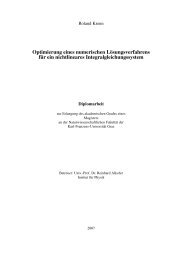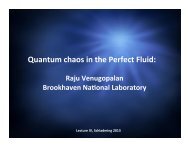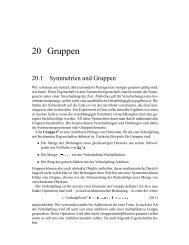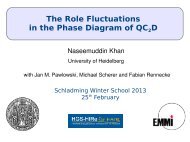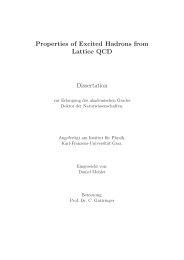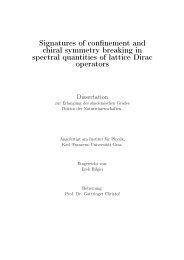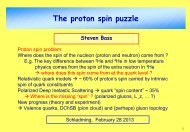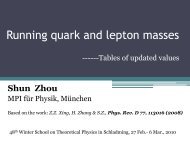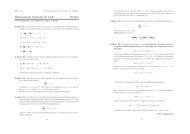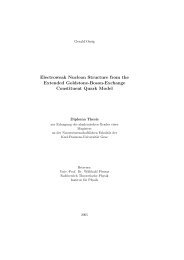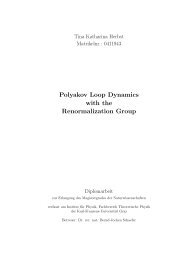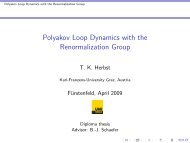The QCD Quark Propagator in Coulomb Gauge and - Institut für Physik
The QCD Quark Propagator in Coulomb Gauge and - Institut für Physik
The QCD Quark Propagator in Coulomb Gauge and - Institut für Physik
You also want an ePaper? Increase the reach of your titles
YUMPU automatically turns print PDFs into web optimized ePapers that Google loves.
82 6.5. Nucleon electromagnetic form factors: results<br />
are [KM01]<br />
〈r 2 p 〉 1−loop<br />
NA n<br />
〈(r µ N )2 〉 1−loop<br />
NA<br />
= ∓ 1 + 5g2 A<br />
32π 2 f 2 π<br />
= − 1 + 5g2 A<br />
32π 2 f 2 π<br />
( ) m<br />
2<br />
ln π<br />
, (6.90)<br />
MN<br />
2 ( ) m<br />
2<br />
ln π<br />
+ g2 A M N 1<br />
, (6.91)<br />
16πfπµ 2 v m π<br />
M 2 N<br />
(µ p n )1−loop NA<br />
= ∓ g2 A M N<br />
4π 2 f 2 π<br />
m π , (6.92)<br />
where g A = 1.26, f π = 0.0924GeV= 1/(2.13 fm), µ v = µ p − µ n . Clearly, the radii diverge<br />
<strong>in</strong> the chiral limit, a frequently advertised aspect of chiral corrections.<br />
While these scheme-<strong>in</strong>dependent terms are fixed, at physical values of the pseudoscalar<br />
meson masses they do not usually provide the dom<strong>in</strong>ant contribution to observables: that<br />
is provided by the regularisation-parameter-dependent terms. This is apparent for baryon<br />
masses <strong>in</strong> reference[H + 02] <strong>and</strong> for the pion charge radius <strong>in</strong> reference[ABR95]. It is<br />
particularly important here, as is made pla<strong>in</strong> by a consideration of the neutron charge<br />
radius. From equation(6.90), one obta<strong>in</strong>s<br />
〈r 2 n 〉1−loop NA<br />
= − (0.48 fm) 2 , (6.93)<br />
which is more than twice the experimental value. On the other h<strong>and</strong>, the contribution<br />
from the low energy constants is [KM01]<br />
〈r 2 n〉 1−loop<br />
lec<br />
= + (0.69 fm) 2 , (6.94)<br />
which is four-times larger <strong>in</strong> magnitude than the experimental value <strong>and</strong> has the opposite<br />
sign. This emphasises the delicate cancellation that is arranged <strong>in</strong> chiral perturbation<br />
theory to fit the neutron’s charge radius. In this <strong>in</strong>stance the rema<strong>in</strong><strong>in</strong>g important piece<br />
is the neutron’s Foldy term: 3µ n /(2Mn 2) = −(0.35 fm)2 , which is also a fitted quantity.<br />
Moreover, for the magnetic radii it is established that, at the physical pion mass, the lead<strong>in</strong>g<br />
chiral limit behaviour is not a good approximation [KM01]. Additional discussion of<br />
issues that arise <strong>in</strong> formulat<strong>in</strong>g a chiral expansion <strong>in</strong> the baryon sector <strong>and</strong> its convergence<br />
may be found <strong>in</strong> reference[FGS04].<br />
S<strong>in</strong>ce regularisation-parameter-dependent parts of the chiral loops are important we<br />
follow reference[ALTY04] <strong>and</strong> estimate the corrections us<strong>in</strong>g modified formulae that <strong>in</strong>corporate<br />
a s<strong>in</strong>gle parameter which mimics the effect of regularis<strong>in</strong>g the <strong>in</strong>tegrals. Thus



